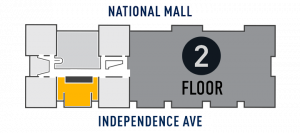This Apollo program simulator demonstrates the view from inside the Lunar Module (LM) during descent to the surface of the Moon. In each lunar landing mission, two astronauts stood inside a LM as they controled the gradual descent of the spacecraft. Sixteen rockets situated around the outer structure of the LM controlled the attitude of the craft. These rockets could be fired automatically by mechanical sensors or by the astronauts' inclinations. Landing on the Moon is unlike landing on Earth. The Moon's atmosphere is extremely thin, which restricted the possibility of a diagonal glide-type landing. Instead, the astronauts landed vertically. The retro-rocket of the descent engine assured a gradual touchdown.
Transferred to the National Air and Space Museum from Grumman Aerospace, the manufacturer, in 1975.
Display Status
This object is on display in Destination Moon at the National Air and Space Museum in Washington, DC.

Object Details
Country of Origin
United States of America
Type
EQUIPMENT-Training Devices
Manufacturer
Grumman Aerospace Corporation
Dimensions
3-D (Artifact (A19760015000) on stand (A19760015000A)): 156.2 × 247.6 × 275cm (5 ft. 1 1/2 in. × 8 ft. 1 1/2 in. × 9 ft. 1/4 in.)
3-D (Artifact (A19760015000) without stand (A1976001500A)): 247.6 × 156.2 × 243.8cm (8 ft. 1 1/2 in. × 5 ft. 1 1/2 in. × 8 ft.)
Materials
Plywood frame. Instruments made of metal, wires, plastic, or various materials.
Inventory Number
A19760015000
Credit Line
Donated by Grumman Aerospace
Data Source
National Air and Space Museum
Restrictions & Rights
Open Access (CCO)
For more information, visit the Smithsonian’s Terms of Use.